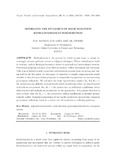| dc.contributor.author | NATHAN, O.M. | |
| dc.contributor.author | LAWI, G.O. | |
| dc.contributor.author | NTHIIRI, J.K. | |
| dc.date.accessioned | 2021-06-09T11:37:34Z | |
| dc.date.available | 2021-06-09T11:37:34Z | |
| dc.date.issued | 2020-03 | |
| dc.identifier.uri | https://doi.org/10.12732/npsc.v26i2.5 | |
| dc.identifier.uri | http://ir-library.mmust.ac.ke/123456789/1675 | |
| dc.description.abstract | ABSTRACT: Radicalization is the process by which people come to adopt in-
creasingly extreme political, social or religious ideologies. When radicalization leads
to violence, radical thinking becomes a threat to national and international security.
Prevention programs are part of an effort to combat violent extremism and terrorism.
This type of initiative seek to prevent radicalization process from occurring and tak-
ing hold in the first place. In this paper we introduce a simple compartmental model
suitable to describe prevention programs in marginalized population by incorporating
government inclusivity. We calculate the basic reproduction number R0. For R0 < 1
the system has one globally asymptotically stable equilibrium where no indoctrinated
and radicals are present. For R0 > 1 the system has an additional equilibrium where
indoctrinated and radicals are persistence to the population. A Lyapunov function is
used to show that, for R0 > 1, the persistence radical equilibrium is globally asymp-
totically stable. Numerical simulation of the model carried out showed that enhanced
government inclusivity leads to a slower rate of transition to radical population. | en_US |
| dc.language.iso | en | en_US |
| dc.publisher | Neural, Parallel, and Scientific Computations | en_US |
| dc.subject | Modeling, dynamics, radicalization , government, inteventioin | en_US |
| dc.title | MODELLING THE DYNAMICS OF RADICALIZATION WITH GOVERNMENT INTERVENTION | en_US |
| dc.type | Article | en_US |

